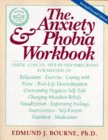 |
Life With Panic/Anxiety Disorder


(Double click on any word to see it's meaning)
God grant me the serenity to accept the things I cannot change.
Courage to changes the things I can,
And the wisdom to know the difference.
Worried you may be suffering from a panic
attack, agoraphobia or some other type of anxiety
disorder?
Check here for the symptoms you
should look for.

Symptoms
Intense fearfulness (a sense that something terrible is happening);
Racing or pounding heartbeat;
Dizziness or lightheadedness;
Shortness of breath or a feeling of smothering;
Trembling or shaking;
Sense of unreality;
Fear of dying, losing control, or going crazy.
People with panic disorder have feelings of terror that strike suddenly
and repeatedly with no warning.
They can't
predict when an attack will occur,
and many develop intense anxiety between episodes,
worrying when and where the next one will strike.
In between times there is a persistent,
lingering worry that another attack could come any minute.
When a panic attack strikes, most likely your heart pounds and you may feel sweaty, weak, faint, or dizzy. Your
hands may tingle or feel numb, and you might feel flushed or chilled. You may have chest pain or smothering
sensations, a sense of unreality, or fear of impending doom or loss of control. You may genuinely believe you're
having a heart attack or stroke, losing your mind, or on the verge of death. Attacks can occur any time, even during
nondream sleep. While most attacks average a couple of minutes, occasionally they can go on for up to 10 minutes.
In rare cases, they may last an hour or more.

Generalized Anxiety Disorder
I have been diagnosed with this anxiety disorder and thought I may be able to help others by describing as best I can. I have used resourses off the net and books I hope this helps you.
Generalized anxiety disorder (GAD) is more than the normal anxiety people experience day to day. It's chronic and exaggerated worry and tension, even though nothing seems to provoke it. Having this disorder means always anticipating disaster, often worrying excessively about health, money, family, or work. Sometimes, though, the source of the worry is hard to pinpoint. Simply the thought of getting through the day provokes anxiety.
People with GAD can't seem to shake their concerns, even though they usually realize that their anxiety is more intense than the situation warrants. People with GAD also seem unable to relax. They often have trouble falling or staying asleep. Their worries are accompanied by physical symptoms, especially trembling, twitching, muscle tension, headaches, irritability, sweating, or hot flashes. They may feel lightheaded or out of breath. They may feel nauseated or have to go to the bathroom frequently. Or they might feel as though they have a lump in the throat.
Many individuals with GAD startle more easily than other people. They tend to feel tired, have trouble concentrating, and sometimes suffer depression, too.
Usually the impairment associated with GAD is mild and people with the disorder don't feel too restricted in social settings or on the job. Unlike many other anxiety disorders, people with GAD don't characteristically avoid certain situations as a result of their disorder. However, if severe, GAD can be very debilitating, making it difficult to carry out even the most ordinary daily activities.
GAD comes on gradually and most often hits people in childhood or adolescence, but can begin in adulthood, too. It's more common in women than in men and often occurs in relatives of affected persons. It's diagnosed when someone spends at least 6 months worried excessively about a number of everyday problems.
Specific Symptoms of this Disorder:
Excessive anxiety and worry (apprehensive expectation), occurring more days than not for at least 6 months, about a number of events or activities (such as work or school performance).
The person finds it difficult to control the worry.
The anxiety and worry are associated with three (or more) of the following six symptoms (with at least some symptoms present for more days than not for the past 6 months; children don't need to meet as many criteria).
- restlessness or feeling keyed up or on edge
- being easily fatigued
- difficulty concentrating or mind going blank
- irritability
- muscle tension
- sleep disturbance
Additionally, the anxiety or worry is not about having a Panic Attack, being embarrassed in public (as in Social Phobia), being contaminated (as in Obsessive-Compulsive Disorder), being away from home or close relatives (as in Separation Anxiety Disorder), gaining weight (as in Anorexia Nervosa), having multiple physical complaints (as in Somatization Disorder), or having a serious illness (as in Hypochondriasis), and the anxiety and worry do not occur exclusively during Posttraumatic Stress Disorder (PTSD).
The anxiety, worry, or physical symptoms cause clinically significant distress or impairment in social, occupational, or other important areas of functioning.
The disturbance is not due to the direct physiological effects of a substance (e.g., a drug of abuse, a medication) or a general medical condition (e.g., hyperthyroidism) and does not occur exclusively during a Mood Disorder, a Psychotic Disorder, or a Pervasive Developmental Disorder.

Recomended Books

From Panic To Power
By: Lucinda Basset
Used from $5.89

The Anxiety And Phobia Workbook
Used from $4.99

Anxiety and Panic Attacks-Their Cause And Cure

Resourses and Links
For Anixety Disorders
Survivors Speak Out
About.com
Click here For treatment for anxiety disorders
Medications
To Read More About Panic/Anxiety
A Ray Of Hope
Di's Panic Anxiety Site
More Pages From
Sunshine's Corner Of The World

SIGN OUR GUESTBOOK!
Email: Sunshine's Email
|



